Shroud
G.O.A.T.
seems like semantics. If you read what Collo wrote and what these other guys are saying they all seem to think you can influence the ball while its on the strings:Yes about acting, but not reacting in 4 ms. And 5 ms is a 25% increase of 4 ms.
(from the OP) I'm an Australian tennis coach based in Singapore and for all beginners and rec players the biggest fundamental flaw I notice that prohibits this level on improving any stroke is the ability to hold/absorb the ball. Push and turn on the ball is key. Create the most resistance on the ball then accelerate with the most mass.
See, he is clearly talking about reacting to the ball or acting on the ball while its on the strings.
IMHO if you slow your swing or change the angle and win the collision less you can keep the ball on the strings longer, but no benefits in slowing the swing.
Anyhow if you have any studies that show its possible or that the pros keep the ball on the strings longer I would like to see that.



